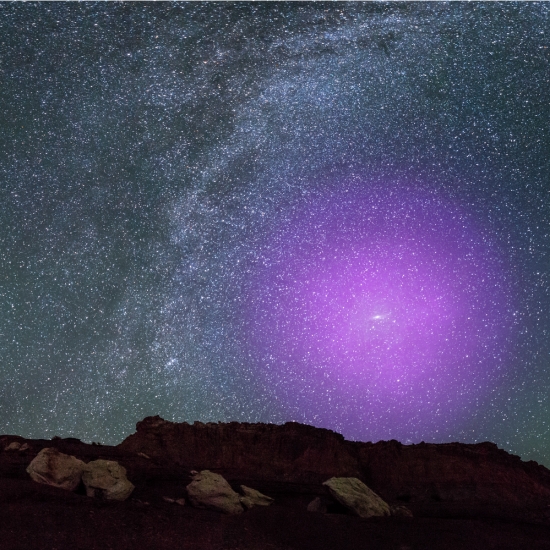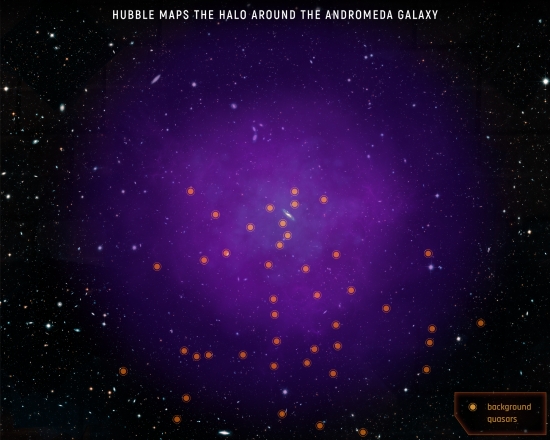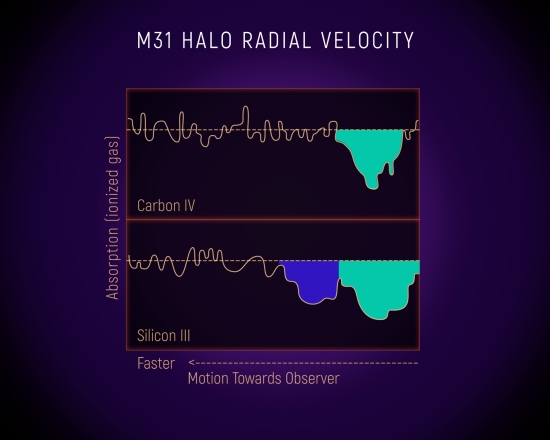Wait long enough — something like 4.5 billion years — and we’ll have a huge elliptical galaxy resulting from the merger of our own Milky Way with Andromeda (M31). I’ve always been fascinated with Andromeda because being the nearest large galaxy, and a fine spiral at that, it gives us a look at how our own galaxy must appear from the outside. Its faintness to the naked eye belies its size, an object considerably larger than the Moon from our perspective, though best seen, of course, on a Moonless night. And now we learn it is even bigger than we thought.
The Absorption Map of Ionized Gas in Andromeda (Project AMIGA) is the source for this information. A new study coming out of this program uses Hubble data to map the vast gas envelope surrounding Andromeda, a diffuse halo of plasma extending 1.3 million light years from the galaxy and in some directions, as far as 2 million light years. To put this into perspective, Andromeda itself is 2.5 million light years away, meaning that our two galaxies may already be encountering each other as their two haloes nudge up against each other.
Now the reference to the Moon gives way to an even larger one. If we could see Andromeda along with its halo, we’d be dealing with an object the width of three Big Dippers. If the entire structure were visible, no other feature of the nighttime sky would be as large. The AMIGA study, led by Nicolas Lehner (University of Notre Dame) reveals the layered nature of this plasma halo, one that contains two nested and distinct shells of gas. Says Lehner:
“We find the inner shell that extends to about a half million light-years is far more complex and dynamic. The outer shell is smoother and hotter. This difference is a likely result from the impact of supernova activity in the galaxy’s disk more directly affecting the inner halo.”

Image: At a distance of 2.5 million light-years, the majestic spiral Andromeda galaxy is so close to us that it appears as a cigar-shaped smudge of light high in the autumn sky. If its gaseous halo could be seen with the naked eye, it would be about three times the width of the Big Dipper—easily the biggest feature on the nighttime sky. Credit: NASA, ESA, J. DePasquale and E. Wheatley (STScI) and Z. Levay.
Sometimes it’s necessary to step back from the minutiae of nearby exoplanet research to see the broader perspective afforded by these cities of stars. Lehner’s co-researcher Samantha Berek (Yale University) calls haloes like these “reservoir[s] of gas” that contain the stuff of future star formation, including the outflows from supernovae. That makes a galactic halo a laboratory for its future evolution, and given its size in our sky, there is no better place to study the phenomenon than Andromeda. Indeed, the team has already found the telltale signs of heavy elements in the halo here, the result of stellar explosions that will seed new worlds.
But despite its relative proximity, how do we go about studying something as diffuse as a galactic halo? AMIGA looks at the light of 43 quasars, those brilliant cores of active galaxies that can be seen in objects much further away than M31. The method: Work with background quasar light as filtered through the Andromeda halo and examine the patterns of absorption in different regions. The data come from Hubble’s Cosmic Origins Spectrograph (COS), working on quasar light in the ultraviolet, a wavelength absorbed by Earth’s atmosphere.

Image: This illustration shows the location of the 43 quasars scientists used to probe Andromeda’s gaseous halo. These quasars—the very distant, brilliant cores of active galaxies powered by black holes—are scattered far behind the halo, allowing scientists to probe multiple regions. Looking through the immense halo at the quasars’ light, the team observed how this light is absorbed by the halo and how that absorption changes in different regions. By tracing the absorption of light coming from the background quasars, scientists are able to probe the halo’s material. Credit: NASA, ESA, and E. Wheatley (STScI).
Ionized gas from carbon, silicon and oxygen turn up in these data, the signature of radiation stripping electrons from atoms. The new maps tune up work Lehner and colleagues performed in 2015, when the Andromeda halo’s complexity was still unknown. Fellow Notre Dame scientist Christopher Howk comments on the scope of the new study:
“Previously, there was very little information—only six quasars—within 1 million light-years of the galaxy. This new program provides much more information on this inner region of Andromeda’s halo. Probing gas within this radius is important, as it represents something of a gravitational sphere of influence for Andromeda.”

Image: This diagram shows the light from a background quasar passing through the vast, gaseous halo around the neighboring Andromeda galaxy (M31), as spectroscopically measured by the Hubble Space Telescope. The colored regions show absorption from two components that make up the halo. For ionized silicon, a significant absorption is shown in both plots. The more highly ionized carbon is absorbed by only one component. Astronomers can tell the two components apart because their line-of-sight motions, known as radial velocity, cause a Doppler shift that changes the wavelength of light being absorbed. Credit: NASA, ESA, and E. Wheatley (STScI).
The size and nearness of Andromeda thus pay off for the study of galactic haloes. Astronomers have examined them in more distant galaxies, but their distance means that there are far fewer background quasars that line up to allow analysis of the haloes. Here we have the kind of extensive sampling from which we can draw meaningful conclusions, using not just one or perhaps two sightlines but over 40, according to Lehner. Future space telescopes working in the ultraviolet will begin to extend such studies beyond the 30 galaxies of the Local Group.
The paper is Lehner et al., “Project AMIGA: The Circumgalactic Medium of Andromeda,” Astrophysical Journal, Volume 900, Number 1 (27 August 2020). Abstract.



This illustration is truly eye-opening, changing our _subjective_ sense of the universe. It is easy to imagine a spiral galaxy as a toilet bowl irrevocably sucking matter down to black hole perdition, yet here we can see it distributing the stuff of chemistry over astonishing distance, as if it were terraforming space itself. The island universes separated by unimaginable distance find themselves tucked in side by side. Is there a potential for formation of new stars and galaxies where these haloes converge?
So we’re approaching the halo. With sufficient proximity, the number of stars would more than double, from the Milky Way perspective. If there is anyone in our lineage left to study it, they may not even be the genus Homo or the family Hominidae. And they may no longer inhabit an Earth incinerated by a red giant Sol: not even be extremophiles would survive that.
A projection in Deep Time, to a moment that none now will be privileged to see.
Using Gaia data, the galaxy merger has been postponed. It now won’t be completed until 10.2 billion years in the future. Very shortly after this, the two SMBH’s will merge, releasing an enormous power of gravitational waves.
https://www.aanda.org/articles/aa/pdf/forth/aa38674-20.pdf
So at first you give me a heart attack thinking the time of the Milky Way and Andromeda galaxies merger won’t happen until 10 billion years from now, which is five billion years longer than previously predicted.
However, upon closer inspection, the merger will actually LAST until over 10 billion years in the future and start roughly 5 billion years from now, as previously predicted. So whew, I won’t miss it after all!
For those who would like free and unhindered access to the paper linked above, here you go, abstract and all:
https://arxiv.org/abs/1908.07278
[Submitted on 20 Aug 2019]
The collision between the Milky Way and Andromeda and the fate of their Supermassive Black Holes
Riccardo Schiavi, Roberto Capuzzo Dolcetta, Manuel Arca Sedda, Mario Spera
Our Galaxy and the nearby Andromeda Galaxy (M31) form a bound system, even though the relative velocity vector of M31 is currently not well constrained. Their orbital motion is highly dependent on the initial conditions, but all the reliable scenarios imply a first close approach in the next 3-5 Gyrs. In our study, we simulate this interaction via direct N-body integration, using the HiGPUs code.
Our aim is to investigate the dependence of the time of the merger on the physical and dynamical properties of the system.
Finally, we study the dynamical evolution of the two Supermassive Black Holes placed in the two galactic centers, with the future aim to achieve a proper resolution to follow their motion until they form a tight binary system.
Comments: Proceedings of IAU Symposium No. 351, 2019A, (MODEST-19), “Star Clusters: From the Milky Way to the Early Universe”. Bragaglia, M.B. Davies, A. Sills & E. Vesperini, eds. 4 pages, 3 figures
Subjects: Astrophysics of Galaxies (astro-ph.GA)
DOI: 10.1017/S1743921319007439
Cite as: arXiv:1908.07278 [astro-ph.GA]
(or arXiv:1908.07278v1 [astro-ph.GA] for this version)
Bibliographic data
Submission history
From: Riccardo Schiavi [view email]
[v1] Tue, 20 Aug 2019 11:31:36 UTC (1,595 KB)
https://arxiv.org/pdf/1908.07278.pdf
Speaking of black hole mergers, has anyone calculated the effects for those who might live relatively near such an event? The ones we find are usually several billion light years away in time and space, where we can just barely pick up the ripples with our most sensitive instruments.
But if the black holes at the centers of our Milky Way and Andromeda galaxies merge, what might happen to the residents of these stellar islands? We are only 26,000 light years from our central black hole at present, if such a term can be used on these cosmic scales.
While the event is extremely luminous extreme consequences are short scale due to the weakness of the gravitational force. That’s why gravitational waves from extreme events are so difficult to detect. Of greater concern is the neighboring SMBH plowing through the Milky Way on its long journey towards that merger event. But that’s a narrow corridor of destruction compared to the effect of nebulae, which would be more widespread and potentially lethal in a fraction of cases. Galactic mergers are responsible for a large spike in star births for this reason.
With that proximity and that size, would the gravity wave amplitude from the Earth-Andromeda SMBH merger be enough to vibrate eardrums or other sensory organs of any species existing on any planet in the galaxy?
Gravity waves, much like sound waves in air, will alternately compress and expand the medium through which they move, viz. space itself. Gravitational “sound” travelling in a vacuum?
Earth’s night sky as Milky Way and Andromeda merge
Posted by Deborah Byrd in ASTRONOMY ESSENTIALS | SPACE |
August 18, 2020
Billions of years from now, Earth’s night sky will change as the Andromeda galaxy rushes toward a merger with the Milky Way.
https://earthsky.org/astronomy-essentials/earths-night-sky-milky-way-andromeda-merge
Well, on the matter of ring side seat to galactic collision, let’s remember that our sun came with a limited warranty itself. Just when the action is about to start, it is out of fuel, if it hasn’t roasted Terra Nostra already.
But back to the gaseous cloud between Andromeda and us. Andromeda has a cloud – but we ( well, the Milky Way) do not? How much mass is associated with this here ( or that there) gaseous cloud spread all over the window frame that we didn’t know about several weeks back? The reason I ask is that decades ago we had the missing matter search that concluded with the non-baryonic explanation of dark matter. Now unless Andromeda is an exception to the rule, a mega-year cloud here and mega light year cloud over there – and everywhere else in the cosmos – … What would Senator Everett Dirksen have said? Sooner or later you are talking about a lot of matter, or else a lot of dark matter identified and removed from the non-baryonic part of the balance sheet.
An amendment to the above about dark matter and halos. I should add that the idea that each galaxy has or might have a gaseous halo. But the illustration gives an indication of how “tangible” it is. Being as observable now as it is, does this change our picture of the quantities of protons, neutrons etc. there are in our cosmic pie chart, or do things remain much the same?
Taking back the number of galaxies…
https://astronomersnotebook.wordpress.com/2021/01/19/the-number-of-galaxies-in-the-universe-and-new-horizons/